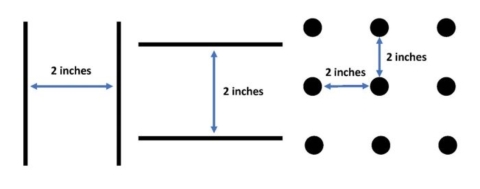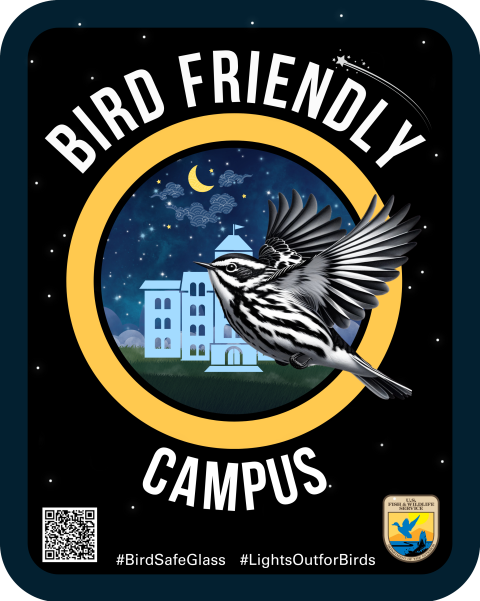About this Collection
Every year, around a billion birds are killed from colliding with glass in the United States. Nearly half of these incidents occur at low-rise buildings like those found at many school campuses. Although some birds seem fine after a collision, most later die from head injuries. Birds struggle to see glass and fly towards the deceiving reflections of habitat like open sky and plants. Sometimes birds are also attracted closer to windows when lights are shining out from the inside. This is because birds are attracted to lights at night, which can also result in birds becoming disoriented and colliding with other lit structures. Fortunately, you can stop birds from hitting windows using inexpensive and attractive solutions. There are a growing number of universities implementing bird-friendly initiatives on campus too.
Join the flock and bring your campus community together for bird conservation!
Do you hear or see birds colliding with windows or other glass at your university?
Signs of collisions often include:
- a sudden "thud" sound as the bird strikes glass
- powder marks of a bird silhouette left behind on your window
- stunned or injured birds on the ground outside
Please note: you may not always see these signs, as bird strikes often go unnoticed. It is reasonable to assume that if you are aware of occasional collisions, then additional collisions are likely also occurring.
At night, does the light from inside buildings shine out the windows and doors? Is the outside area on your campus lit up with landscaping, door, flagpole, or parking lot lights?
Birds are attracted to artificial lights at night, which often increases their risks of collisions when they fly off their intended path towards the light leaking out our windows or shining off lit structures. You may see birds circling lights on top of buildings or other structures at night, which can lead to them becoming exhausted and disoriented. Universities can address this issue by turning off or dimming exterior lights at night and by closing curtains or blinds to prevent light leak from the inside out. If lights are needed, it can also be helpful to install lights with timers and/or motion sensors around campus. These actions also save energy, operation costs, and increase the health benefits for humans when we have less light pollution and restored starry night skies. It is especially important to decrease light pollution during peak spring and fall migration periods when most birds in North America travel at night between 10 PM and 4 AM.
Are there any bird feeders or water sources within around 16 truck lengths (165 ft) of campus glass or windows?
- Buildings with bird feeders or other attractants are more likely to cause bird collisions.
- Ask your university to prioritize bird-friendly glass retrofits in areas closest to bird attractants.
Glass, lights at night, and attractants like feeders ALL need to be considered to fully address the threat of bird collisions. Let's get started!
Monitor Your Glass for Collisions
If you can identify where birds are colliding most on your campus, you can prioritize which windows to address first. However, it is best practice to make all of our glass windows bird-friendly to reduce collision risks as much as possible.
Bird-friendly window treatment options include:
Window Films: transparent films with patterns that are visible to birds but minimally intrusive to people's view. They can be applied directly to existing windows and are often removeable.
Window Decals: place decals on windows in patterns or shapes spaced 2-inch by 2-inch apart.
External Screens or Netting: this method can break up reflections and provide a physical barrier birds can see.
Paracord Curtains: closely spaced vertical ropes or cords hanging in front of windows.
UV Reflective Glass or Coatings: some glass products or coatings reflect ultraviolet light, which birds can see but humans cannot, making the glass appear as an obstacle to birds without impacting the windows aesthetic.
Fritted Glass: small ceramic dots baked into the glass surface, creating patterns birds can detect and avoid.
One-Way Transparent Film: film that appears opaque from the outside, maintaining the view for people looking out.
Tempera Paint: get creative with washable window paints, but be sure your designs are spaced no farther than 2-inch by 2-inch apart across the majority of the window to be effective.
External Shading Devices: awnings, overhangs, and external blinds can reduce reflectivity, especially when the sun is low. Note: this method is not always as effective as the others.
How can you help?
- Contact school leadership about starting bird-friendly campus initiatives (template letter).
- While not always necessary, starting a Bird-Glass Collision Monitoring Program with your peers can be helpful to keep close attention to where and when birds collide at your facility so you can identify areas to prioritize. Bird carcasses, feather prints and feathers stuck to glass are good indications of collision problems and reasons to retrofit glass.
- Note: All glass has the potential to cause bird collisions, even small windows and interior atriums. Monitoring requires time and energy that could otherwise be allocated to glass retrofits or other collision prevention efforts. Sometimes monitoring can cost more than retrofitting the glass and preventing collisions.
- Share options available for window, glass, and lighting retrofits with facility managers and leadership.
- Post about collision prevention, lighting reduction, and communication tower collisions on social media.
- Post a sign explaining to building visitors why they might notice building changes.
- Publish an article in the university newspaper about reducing bird collisions on campus.
- Post signs to motivate students to close curtains in dorms and turn off lights to reduce bird collisions.
- Start an art contest encouraging peers to use washable tempura paint to make their windows visible to birds on campus (with permission from your University).
Do you work in a school for grades K-12?
Check out this educational presentation: Flight Migration and Collision Prevention.
These teaching slides were adapted from the Cornell Lab K-12 Education team. Other classroom resources developed by the Cornell Lab K-12 Education team can be found here:
- https://www.birds.cornell.edu/k12/get-started/
- https://www.birds.cornell.edu/k12/science-nature-activities-for-cooped-up-kids/
Spread Awareness and Share your Conservation Actions!
We can amplify bird conservation efforts by increasing awareness and encouraging action within our communities. Inspire others on social media with #BirdSafeGlass, #BirdFriendly, #BringBirdsBack, #SafeSkies, and #LightsOutforBirds!
Let’s make bird conservation a social norm!
Does your campus have a communication tower lit with non-flashing lights at night?
Check out the Bird-Friendly Communication Tower Toolkit!


